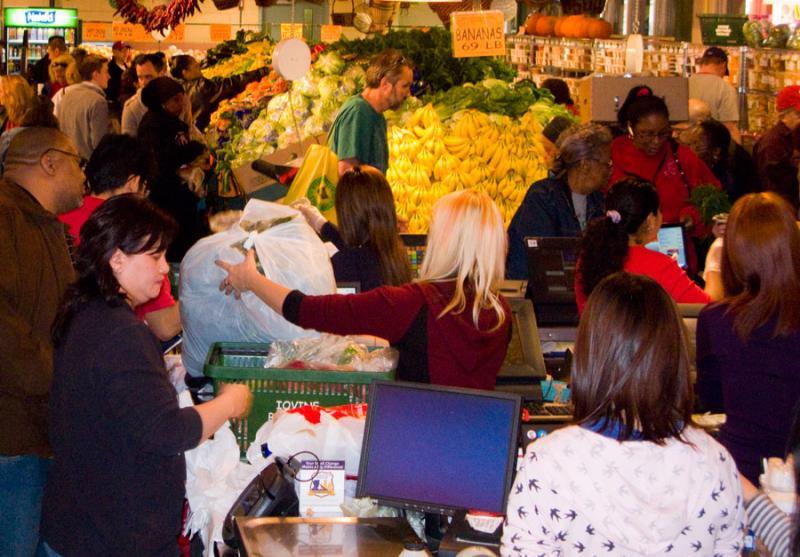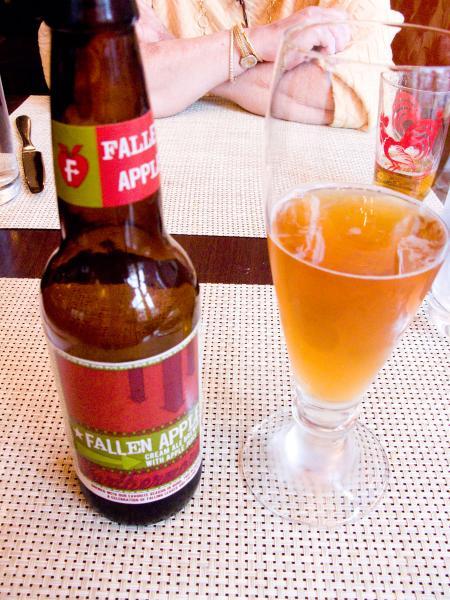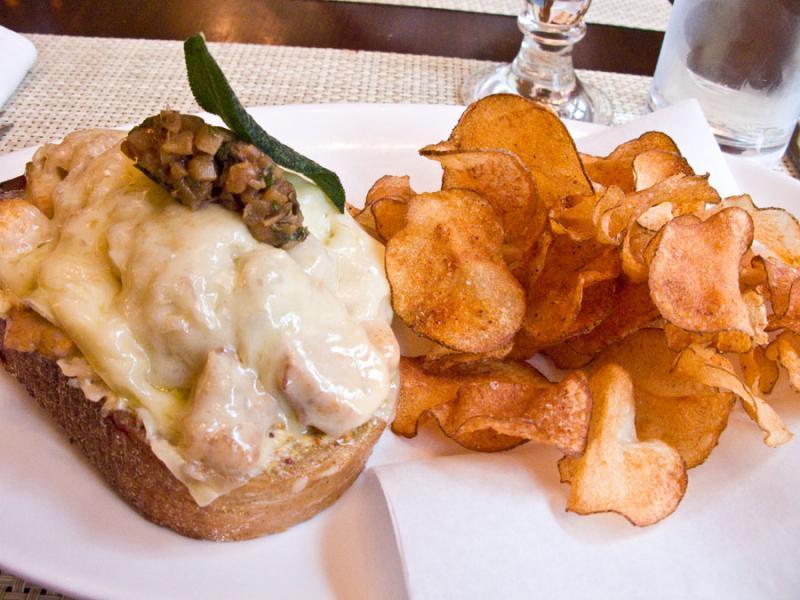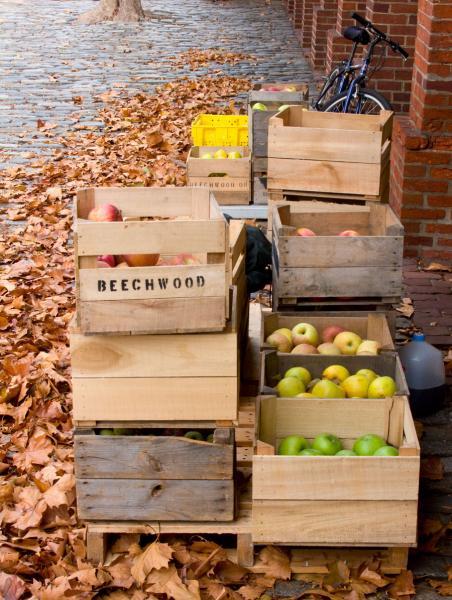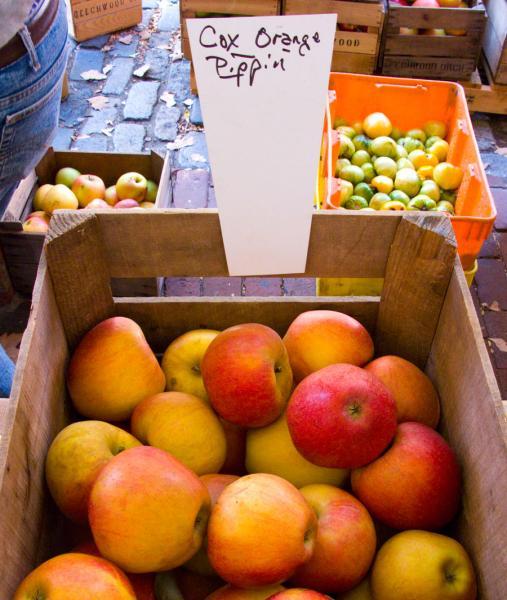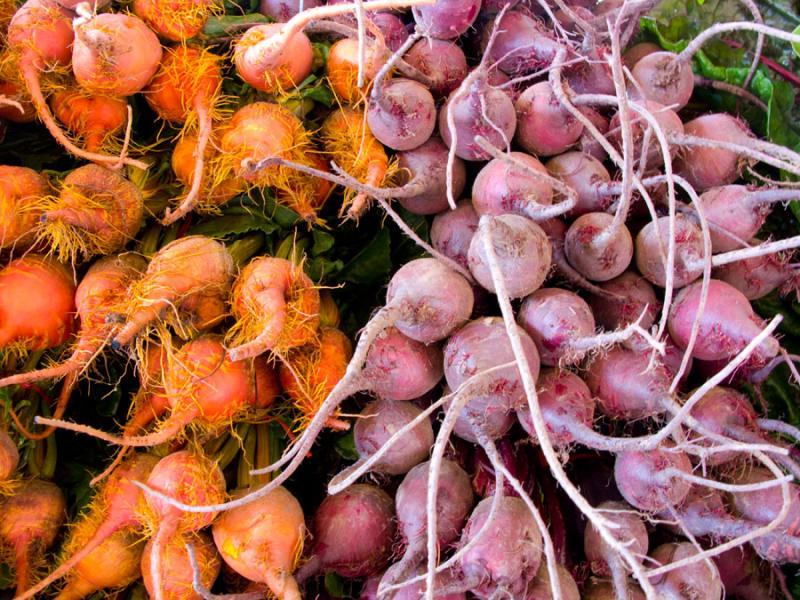-
Posts
3,022 -
Joined
-
Last visited
Content Type
Profiles
Forums
Store
Help Articles
Everything posted by rlibkind
-
Dave Garretson of Beechwood Orchards, who sells at the Headhouse Square Farmers' Market, loves his apples, and this week he had one of the best, the Newtown Pippin. This variety probably originated in the early 18th century in what is now the Elmhurst area of Queens, New York. (Take the Brooklyn-Queens Expressway and you'll cross Newtown Creek). It was beloved by Thomas Jefferson, Benjamin Franklin, and Queen Victoria. The Newtown Pippin (unlike my favorite, the Cox Orange Pippin) is one of the great storage apples, which only gets better with age: I plan to delay the gratification of eating them until February, by which time their sugars will be fully formed and balance the tart, piney, citrusy, nutty flavor of this American classic; kept in cold storage with adequate air circulation (a perforated bag in your refrigerator's crisper), they'll probably keep until spring. Eat them now and you'll only get a glimmer of their complexity. Today it's rare to find Newtown Pippins in the fresh market. Most are turned into juice, thanks to its clear, flavorful nature. If you've enjoyed Martinelli's sparking cider. you've consumed Newtown Pippins. Martinelli's purchases, at above market prices, have prevented the California plantings of Newtown Pippins from being uprooted in favor of other crops. This revered variety was pushed out of the fresh market over the last 20 years by the Granny Smith, which offers only a hint of the wonders of the Newtown Pippin, but is more visually appealing than the frequently lopsided antique apple, whose countenance can appear marred because of natural russetting near the stem end. In addition to California, the Newtown Pippin was a favored variety in tidewater Virginia, where the parochials renamed it the Albemarle Pippin, not wanting to keep the Yankee name. It was a major export item to England until the early 20th century when tariffs decimated that market. Although the Newtown Pippin works well in pies, as well as apple sauce, it's highest uses are for cider and as a dessert (fresh eating) apple.
-
The aisles were crowded at Iovine Brother's Produce at the Reading Terminal Market this morning as shoppers sought veggies for their Thanksgiving tables. Once you managed to fight your way through the aisles, however, checkout was a snap: Jimmy and Vinnie Iovine rigged up a couple of additional registers, so there were an even dozen cashiers working. Once reason for the crowds might have been the prices. White utility and Idaho potatoes, in five-pound bags, would set you back only $1.99. A 10-pound bag of non-Idaho russets were an even better deal, $2.99. Red potatoes were a relatively pricey, but still thrifty, $2.99 for a five-pound bag. Onions were a good deal, too, at a buck for a two-pound bag (red or yellow). Three-pound bags of carrots were selling for two for $3. The green beans for your classic canned fried onion-topped casserole, however, were $1.99/pound, about twice as much as you'd pay at peak season. If you like some bay leaf in your stuffing, tray packs of fresh leaves were $1.99. Among the non-Thanksgiving produce, limes have tripled in price, to 3 for $1. Hass avocados were two for $1.49. e.jpg]
-
When winter arrives, I'm a big fan of frozen fruit, particularly berries. Nothing like some tasty, sweet and tart blackberries to mash up with a full-fat yogurt for breakfast. With its recent expansion the Fair Food Farmstand at the Reading Terminal Market has more room in its freezers, so it's added another fruit to its small frozen selection: strawberry puree. The one-pound packs from Green Meadow Farm, a delicious looking red, are priced at $5. I haven't tried them yet, but I can't imagine theyd be anything but excellent. Another summer fruit you can enjoy in winter are peaches. Canned peaches from Three Springs Fruit Farm (one of the vendors at Headhouse) can also be found at Fair Food; I went through a few cans last winter and thoroughly enjoyed them.
-
It definitely was not the all-beef, natural casing version of the D&W dog, at least the version I'm familiar with.
-
I lunched today at Supper, a restaurant in Philadelphia, and the presence of one particular beer on the menu dictated my choice of sandwich. Before I saw the beer list I was dithering among a lamb pastrami sandwich, a house-made hot dog, and a pork belly reuben. When I saw the beer list my eyes immediately went to Fallen Apple, a cider-beer brew that demanded to be eaten with pork. So I went for the reuben. The open-faced sandwich on Jewish rye included apple as one of its components, along with Thousand Islands dressing, sauerkraut, gruyere and the gelatinous, fatty pork belly. Freshly fried, greasless "pastrami" flavored potato chips finished off the plate. The beer (actually a cream ale, like my other favorite Wisconsin brew, Spotted Cow) comes from Furthermore Beer in Spring Garden, though it's produced under contract by Sand Creek way up north in Black River Falls. This year's version uses tart apples from a local orchard and adds the freshly pressed cider to the fermentation. The end product is almost as much cider as beer, and reminds me of scrumpy from Devonshire, though a tad less alcoholic at 6.2 abv. While a lot of folks say they don't like fruit beers, I think this would make converts of many. It's definitely full of sour apple-ness, but the cream ale adds balance. Not a session beer, but great with the right food. Think pig, the more rustic the better.
-
She Who Must Be Obeyed and I decided to lunch at Supper. She had the hot dog (see the hot dog topic for comments on that), I went for the pork belly reuben. The sandwich, served open-faced on good Jewish rye (no, it didn't make it kosher) lathered with Thousand Islands dressing, nice slice of gelatinous, fatty belly (though not crispy as advertised on the menu), sauerkraut, gruyere and apple. When brought to the table, I thought all the "reubenesque" additives would overwhelm the pork, but they didn't. While the pork flavor didn't dominate, it was there and worked well, particularly with the kraut and apple, which are traditional pork accompaniments. The homemade "pastrami" flavored potato chips, thin, crispy and greasless, added a nice crunch to the plate. In ordering, I was torn between the hot dog, the reuben and the lamb pastrami sandwich. What clinched my choice was the presence on the beer list of Fallen Apple, a cream ale brewed with fresh-pressed apple cider from Furthermore Beer of Spring Green, Wisconsin. (It's actually produced for Furthermore by a contract brewer, Sand Creek, up north in Black River Falls.) As I noted about the sandwich, apples and pork product are a natural combination (apples are picked and pork slaughtered at the same time of the year). Apple-flavored beer might not be for everyone, but it's worth trying when you've got the right food to go with it. While I wouldn't order it as a session beer, it was an excellent pairing for this lunch.
-
I hit both Moe's and Supper (yesterday and today, respectively). I like everything about Moe's . . . except the hot dog. I don't know whose dog they use, but it had that heavy, liquid smoke taste I abhor. Too bad, because the rolls were way above average, with enough heft to handle just about any load of fixings. I had one chili dog and one "works" with kraut, mustard and relish (I skipped the onion) and, except for the hot dog itself, found it good. At Supper, She Who Must Be Obeyed ordered the dog (I went for the pork belly reuben), but I enjoyed my taste. The smoke was there, but not nearly as overpowering as at Moe's. If the emulsification had been just a little bit less, you could call it a sausage, but it was definitely a hot dog. She skipped the kraut, a processed brassica to which she recoils in horror, but enjoyed the bacon and all the other fixings. The New England style roll, as Holly observed (who happened to be enjoying the hot dog a couple tables away, we discovered after we finished our meals), was a nice touch, complete with being grilled in butter. And those buttermilk batter fried pickle slices were astonishingly good -- I could eat a small plate of just those to accompany some beer. We shared a bottle of Fallen Apple, a Wisconsin cream ale brewed with apple juice. It was very tasty with the reuben.
-
Thanks for the perspective, Nxtasy. I was looking beyond the pioneering chefs and entrepreneurs, and instead looking for the basic economic reasons as to why they decided to stake out their claims. Since I've only visited Sheboygan once (though I certainly intend to return), I was unaware of the economic development of the city as a resort community. Ah, supper clubs. Though I'm not native to Wisconsin, I'm a frequent visitor and I love the concept and, in most instances I've sampled, the execution. Nothing like a relish tray filled with celery, carrots, radishes, scallions and olives, all atop crushed ice! And a martini. Are there any classic supper clubs left in Sheboygan? And, if anyone is still interested in pizza, here's Il Ritrovo's version of margherita (with anchovies I ordered as an addition):
-
$4.99/pound for Spanish mackerel seems just a tad expensive. It usually goes for about $2.49-$2.99 at the Reading Terminal Market in Philadelphia. Must be the transport costs, since this is basically a Mid-Atlantic and Southern fish. Not much is caught commercially from Massachusetts northward, and most of the U.S. harvest is from Florida, with NC a very lagging second.
-
I think the presence of Kohler, more than an other single factor, is responsible for Sheboygan having more good restaurnts that most cities its size.
-
Potato in one form or another seems to be the most common appurtenance for smoked haddock!
-
Peter, that's like asking which of your offspring is your favorite! You might have one, but you try not to show it. To paraphrase Yip Harburg, when I'm not near the mollusk I love, I love the one I'm near. When I visit Maine, it's got to be the belly clam, steamed and dipped in the broth, which I then drink when I've gone through two or three pounds with a couple of beers. Of course, en route to Maine requires a stop in the Essex, Massachusetts, area, where the same clams are fried in cornmeal to perfection. In South Philly it's hard to pass by mussels in red sauce. In Brussels it's Moules Mariniere, accompanied by frites and an Alsatian white. And any small-sized oyster from cold, northern waters on the halfshell. (This weekend I sampled some excellent Cape May Salts, which deserve their adjectival moniker.) Except when I want fried oysters on a po' boy, when I like them large to accent the textural difference between the crunchy cornmeal coating and the creamy interior. Razor clams are pretty good fried, too. Another fried oyster classic is to have this bivalve served atop a small mound of chicken salad. It's a Philadelphia classic with a great ying-yang of taste and texture. Squid steak. I had some in Douglas, Alaska, just across the bridge from Juneau and it was very good.
-
Besides whisky, one of the Scots' great contributions to good eating is finnan haddie, a.k.a. smoked haddock. Today I found some tasty examples at the Wegman's store in Cherry Hill, New Jersey, a Philadelphia suburb, priced at $8.99/pound for tray-packed fillets. The light smoking gives these small sides of haddock a long shelf-life; the pack I bought has a pull date of December 31. In conversation with the knowledgeable fish manager at Wegman's, I learned these babies came from a Massachusetts supplier (New Bedford, iirc). He opened a pack so we could taste some. Haddock is a fish that needs to be lightly smoked, and the sample I tried was done right. The flesh was very firm, the pellicle lightly-colored and thin. It was smoked not quite as much as one of the classic Scottish varieties, Arbroath Smokies, but I don't find that a negative. How to use the smoked haddock? Since I'm fond of fish soups, Cullen Skink is one possibility. This classic Scottish milk-based chowder relies on mashed potato as its thickener, otherwise it's not at all that different from a classic New England fish chowder (done with milk, not thickened absurdly so a spoon can stand in it, as many fish house versions would have you believe). I could also do fish on a shingle, i.e., prepare it the same way you could creamed chipped beef and serve over toast or home fries. Now that's a breakfast of champions! Most likely I'll make a spread, mashing up the fillet with cream cheese, adding some onion, parsley and fresh ground pepper. Sitting in the Wegman's refrigerator case next to the smoked haddock were packs of dressed and headless kippered herring. Another possibility for a champions' breakfast when served along scrambled eggs. Think of kippers as the bacon of the sea.
-
I can particularly recommend Il Ritrovo, which makes one of the best classic pizzas in the country. Expect a line on weekends. As good as Chris Bianco's in Phoenix.
-
Yesterday's Forgotten Foods Festival at the Reading Terminal Market opened my eyes, and tastebuds, to some old-time flavors of Philadelphia and envir0ns. By the time I left the market shortly after 11 a.m. (the festival began an hour earlier), center court was crowded with regular shoppers, the normal passel of tourists, foodies drawn by the festival, and early Christmas shoppers attracted by the Philadelphia Museum of Art's annual crafts show across the street at the Convention Center. A particular revelation to me was the Cape May Salts, an oyster brought back from oblivion a few years ago by Atlantic Cape Fisheries, a Cape May-based company. Once upon a time the Delaware Bay was teeming with oysters, hence the proliferation in the late 19th and early 20th centurys of oyster houses in Philadelphia, once as common as today's pizza parlors, according to Atlantic Cape. In the 1950s, disease wiped out the commercial oyster industry in Delaware Bay. It took the development of disease-resistant oysters by Rutgers University and Atlantic Capes to reestablish the commercial oyster in Delaware Bay. (The Cape Mays were dispensed by the Fair Food Farmstand's Forgotten Foods stall.) Oysters from New England, the Northeast and Mid-Atlantic are traditionally briny, but the Cape May Salts deserve their adjectival moniker more than most. The salt flavor is pronounced and delicious; these would be perfectly accompanied by a local lager, say Yuenglings or Yards. Oysters also appeared in one of the offerings from Pearl's Oyster Bar. I've haven't eaten at Pearl's recently because previous times I'd eaten there I was disappointed: the snapper soup was way too gloppy, and the breading on the fried seafood way too doughy. That wasn't the case with what I sampled yesterday. The large, Chesapeake-style oysters in the Oyster and Chicken Salad sample was more modestly breaded and perfectly fried, the chopped chicken bound with as little mayonnaise as possible. Put them together and you've got a ying-yang food with much appeal. The little sample of Snapper Soup also was unlike what I tried previously. It might have had some corn starch to give it body, but not much. Based on these two items I'm going to give Pearl's lunch counter another try. Old style oyster crackers -- Old Trenton Crackers -- were the media used for conveying the freshly grated horseradish offered by Hershel's East Side Deli. The pungency of the fresh grated variety is head and shoulders over the jarred imitators. Because Hershel's used an electrically-powered mechanical grater, it lacked the frisson provided by the knuckle skin that found its way into the condiment that accompanied our gefilte fish during the Pesachs of my youth. Another revelation could be found in the black walnut cupcakes sold by Fair Food. The cupcakes, made by Flying Monkey Patisserie, used black walnuts from Green Meadow Farm, one of Fair Food's suppliers. Topped with a cream cheese-buttercream frosting, these are among the best tasting "adult" cupcake I've ever sampled. Another dessert offered was teaberry ice cream from Bassetts. While the small cup I tasted was as creamy and rich as any produced by Bassetts, the teaberry flavor (one I always enjoyed in gum) failed to impress as an ice cream. The flavor, much like wintergreen mint, was too bubble-gummy for me, especially with its neon pink color. The only other item I tried as the festival was the corn pudding offered by Pennsylvania General Store, made with Copes corn, a dried, toasted Pennsylvania Dutch staple. Cooked to a bread-pudding like consistency and accented with what I took to be little bits of dried fruit, this was a wonderful combination of savory and sweet. It would make a fine addition to anyone's Thanksgiving table. Among the items I missed was the liverwurst from S&B Meats and Down Home Diner's catfish on waffles, served by Jack McDavid. If anyone can report on those items, or any other I've missed, please do!
-
The black dirt farm country of Orange County, New York, is ideal for growing onions. And Iovine Brothers Produce has them at the Reading Terminal Market. Yesterday Iovine's was selling two-pound bags of either yellow or red onions from that growing area for $1 a bag. Also spied at Iovine's: Chilean avocados, two for $1.49; Brussels sprouts stalks, $1.99; red bell peppers, $1.49, which was less expensive than the green, orange or yellow bells, all $1.99; limes continued to be obtainable at a dime apiece. Brussels sprouts stalks (they called them "trees" at Iovines) were available from some of the other farm vendors: $7.50 at Fair Food, $4.95-$5.95 at Earl Livengood's. Fair Food featured what might be the last of the seasons local tomatoes, pints of organic cherry tomatoes for $4.50. The poblano peppers, $4.50/pound, looked good. At Kauffman's Lancaster County Produce celery stalks were $1.99 ($2.49 for hearts). Livengood's celery and celeriac were both priced at $3.95/pound.
-
Dave Garretson of Beechwood Orchard, who sells at Headhouse Square, has changed his pricing system. Until this week, he priced his fruit by the pint or quart. It was always good value, but you had to take it home and weigh it out to get a good comparison with other vendors. Starting today he switched to strict by-the-pound pricing. His apples were $2/pound, pretty much in line with other vendors. And he's still got Cox Orange Pippins. Dave's only fear is that he's going to have to restrain himself when picky customers threaten to bruise the fruit next peach season
-
Ikea would be the best bet for a meal. There are a number of food vendors who show up at Scanfest each year at Vasa Park in Budd Lake (usually held Labor Day weekend), but few of them operate actual retail establishments. One that does is Viking Bakery, 34 First Ave., Denville (973)627-7333. I haven't visited their shop, but their kringle I tasted at the festival a few years was okay, though not nearly as good as you'd find in Racine, Wisconsin. Viking is pretty much a neighborhood cake and bun bakery, as best as I can determine. Here's a link to a list of food vendors from prior years at the festival. I've perused it but can hardly find any that have actual stores/restaurants in NJ other than Viking. Scanfest Food Vendor List If you're in North or Central Jersey (I've even made the trip prior to the holidays from my home in center city Philadelphia), the best bet for purchasing food products and ingredients would be to make a trip to Brooklyn. Nordic Delicacies isn't far from the Verrazano Narrows Bridge in Bay Ridge, which still retains just a bit of Norwegian heritage (largely overwhelmed by Arabic culture these days). Nordic Delicacies has a good range of packaged products (much wider selection than Ikea), plus a number of meat and other items they make on-premises. Certainly holiday items (like pinnekjott, dried lamb rib) have to be ordered in advance. I particularly like their rullepolse (brined, pressed, herbed cold cut). Here's a website link: Nordic Delicacies
-
Re: Caol Ila. Funny, a lot of folks regard this as a "gateway" malt to the Islays. Not nearly as pronounced in the flavors that distinguish Islays as say, Lagavulin or Laphroaig. But, as you suggested about oysters, De gustibus non est disputandum. Caol Ila is, fwiw, a constituent in Johnny Walker Green and, I believe, other JW blends.
-
Well, I was wrong about Freitag.
-
I've been telling Dave Garretson of Beechwood Orchards about Cox Orange Pippins for a couple of years now. This week he found some on a neighbor's orchard and brought them to Headhouse Square. Although these apples were picked about a month ago and have been in storage, they've hardly lost anything. Indeed, this variety ripens best after picking. Cox Orange Pippins are only moderately crisp (those who insist on absolutely crunchy crispness will be disappointed), but their flavor is second to none, with a perfect balance of sweetness and tartness. Many believe, as I do, that it's the world's finest dessert apple, i.e., for eating uncooked. It's no wonder that Cox Orange Pippins are the most popular apple in the U.K., so much so that they're imported from South Africa in the off-season. (Alas, because they are more susceptible to disease, it's likely to lose this distinction soon, as more growers shift to other varieities.) This variety first appeared in 1825 in England. And if you think the taste is vaguely familiar, you aren't imagining it. Today's Gala apple is a less flavorful but hardier descendant.
-
Tom Culton, shown today behind his Headhouse Farmers' Market stand laden with colorful cauliflower, loves produce in all its varieties. So much so that, according to an article in Citypaper this week, he raises 63 varieties of garlic. Read it here.
-
-
At least some merchants and the Reading Terminal Market have seen business fall off dramtically due to the SEPTA strike. One of Iovine Brothers Produce's managers said volume was off 40 percent. On top of that, he and fellow managers had become a de facto taxi service, driving employees to and from work. Other merchants saw lesser impacts. Over at the Fair Food Farmstand, while business was off a little, it wasn't devastating.
-
I'm only about a quarter into this book dedicated to the Jewish deli, but it is fascinating. Although author David Sax may have omitted reference to your favorite deli, anyone who enjoys a good pastrami sandwich or plate of kishke will say a b'rucha for this book. I purchased the book last Tuesday at a signing in connection with Sax's appearance in the Free Library of Philadelphia's author series. Coincidentally, Tuesday was National Sandwich Day, the birthday of John Montague, reputed to be the inventor of the sandwich. (A blatant lie.) In his talk, Sax outlined the two primary reasons why the Jewish deli is in such serious decline (from a couple thousand in the early part of the century in New York City to maybe a couple hundred today). The first reason is simple economics. The traditional foods served by the deli have very high material costs. The margin on that $9 or $14 pastrami sandwich will be a buck at best. Add in high rents (especially in Manhattan) and labor costs and you've got a business challenge of the first order. The second reason -- and the one Sax spent most of his time discussing -- is culture. He quickly touched on a variety of cultural reasons for the deli's decline (generational change, changes in food tastes, etc.), but I found one particularly interesting: No homeland for keeping the tradition alive. For example, the reason why Italian restaurants are still going strong, even though changes in U.S. immigration law largely shut off the Italians as much as the Jews in 1920, is that there is still an Italy with a thriving, evolving food culture. Same goes for the various Asian cuisines and just about any other ethnic cuisine you can think of. Not so Ashkenazi Jewish cuisine: the Holocaust wiped out the Ashkenazi Jews of Europe and, with it, the natural homeland of their cookery. That's not true of the style of Jewish cuisine that has most recently taken root and thrived in America, Israeli/Middle Eastern cooking. Falafel stands are ubiquitous, as Israelis migrate to the U.S. and open restaurants offering their home cooking, as reinterpreted here in America. Because there is an Israel with its own cooking traditions (albeit, adapted from Arabic cultures, just as Ashkenazi cooking adapted from Polish, Germany, French and other european cultures), there is a living base from which to grow. In his Philadelphia talk, Sax offered a number of possible solutions -- including his belief that delis should eschew buying finished corned beer and pastrami from the large processors, like Hebrew National (a unit of Conagra), and instead cure their own meats and make everything they can on premises. Since he was speaking in Philadelphia, he singled at Hershel's East Side Deli in the Reading Terminal Market as a fine example. (That's where he lunched.) Sax is definitely going to be a big hit at all the pre-Hanukah Jewish Book Fairs around North America. The fact that he's from Toronto and has a passion for Montreal smoked meat, you shouldn't against him hold. David's web site: Save the Deli



